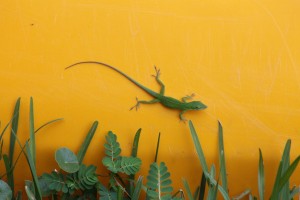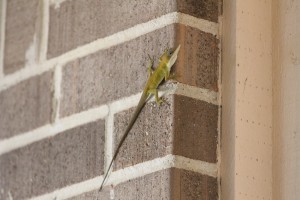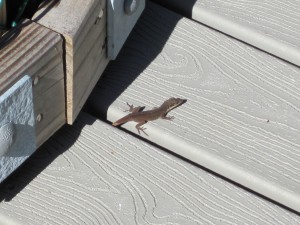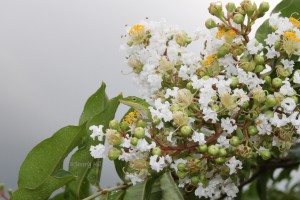Anolis carolinensis, or the Green Anole, is often inaccurately referred to as the “chameleon” of North America. It is a fascinating little lizard that many people have only seen in pet shops or zoos. Anoles are a common reptile found mostly in the southeastern United States, and in colonies in Hawaii and Guam. They can be found amid shrubs, vines, and trees where they prey upon small insects such as flies, moths, spiders, and roaches.
Physical Characteristics of Anoles
During the breeding season, which lasts from about April to September, both male and female anoles can be seen extending the brightly colored pink dewlap beneath their throat in an elaborate courtship dance consisting of head bobbing, push-ups, and open-mouth displays in their attempts to win a mate. These displays are often used during territory disputes as well.
Males are larger at about 8.5 -9 inches in length and have dewlaps that are roughly three times the size of the female dewlap. Females average six inches in length. These lizards are a prime example where size matters; the larger the male, the more females will be found in his territory, and each female is capable of laying one egg per week during the mating season.
Lizard Defense Mechanisms
One of the anole’s defense mechanisms is its ability to change from a brilliant green coloration to a dull brown in mere seconds. It uses this ability to camouflage itself against leaf litter or bark in order to prevent predators from locating it. Anoles may also turn brown in times of stress, such as overpopulation, or illness.
Anoles can bite when provoked or threatened, and in extreme cases, their tails will break off in an effort to distract predators so they can escape. The tail will regrow over time. Despite their defensive nature, they adapt to captivity rather well and make a good beginner lizard for those wishing to study them or to simply have one as a pet.
Lizards and Science
It may come as a surprise that the innocuous green lizard that spends its day sunning itself on the fence post is also being used in scientific behavioral research in an effort to better understand such conditions such as Obsessive-Compulsive Disorder and Tourette’s Syndrome. In 2005, the anole was chosen for the NHGRI (National Human Genome Research Initiative) genome sequencing program.
So, not only are lizards beneficial in helping to combat pests, but they’re also helping scientists answer questions about the human brain itself. It just goes to show, big things can come in small packages.
[amazon_enhanced asin=”0813036682″ /]




